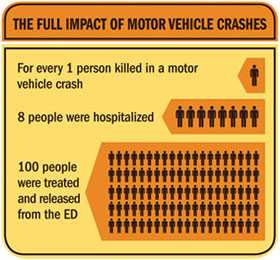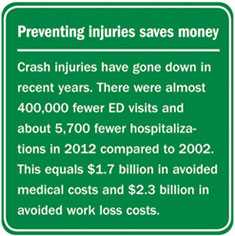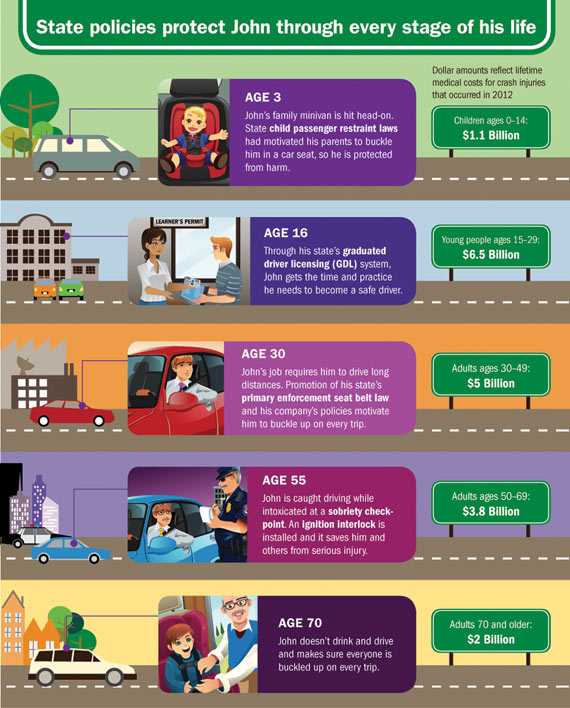Motor Vehicle Crash Injuries
Costly but Preventable
October 2014


 1M
1M
Americans spend more than 1 million days in the hospital each year from crash injuries.
 $18B
$18B
Crash injuries in 2012 totaled $18 billion in lifetime medical costs. More than 75% of costs occur during the first 18 months following the crash injury.
 $33B
$33B
Lifetime work lost because of 2012 crash injuries cost an estimated $33 billion.
More than 2.5 million Americans went to the emergency department (ED)—and nearly 200,000 were then hospitalized—for crash injuries in 2012. On average, each crash-related ED visit costs about $3,300 and each hospitalization costs about $57,000 over a person's lifetime. The best way to keep people safe and reduce medical costs is to prevent crashes from happening in the first place. But if a crash does occur, many injuries can still be avoided through the use of proven interventions. More can be done at every level to prevent crashes and reduce injuries, but state-level changes are especially effective.
State officials can:
- Consider using proven interventions that increase the use of car seats, booster seats, and seat belts; reduce drinking and driving; and improve teen driver safety.
- Support traffic safety laws with media campaigns and visible police presence, such as those used with sobriety checkpoints.
- Link medical and crash data to better understand why crashes happen, the economic cost of those crashes, and how to prevent future crashes.
Problem
Motor vehicle crashes are a leading cause of injury in the US—harmful and expensive.
What works to prevent crash injuries?
- Using primary enforcement seat belt laws that cover everyone in the car. A primary enforcement law means a police officer can pull over and ticket a driver or passenger for not wearing a seat belt. A secondary enforcement law means a police officer can ticket a driver or passenger for not wearing a seat belt only if the driver has been pulled over for some other offense.
- Having child passenger restraint laws that require car seat or booster seat use for children age 8 and under, or until 57 inches tall, the recommended height for proper seat belt fit.
- Using sobriety checkpoints, where police systematically stop drivers to check if they are driving under the influence of alcohol.
- Requiring ignition interlocks for people convicted of drinking and driving, starting with their first conviction. Ignition interlocks check and analyze a driver's breath and prevent the car from starting if alcohol is detected.
- Using comprehensive graduated driver licensing (GDL) systems, which help new drivers gain skills in low-risk conditions. As drivers move through the different stages, they receive more driving privileges, such as driving at night or with passengers. Every state has GDL, but the specific rules vary.
Each of these strategies can prevent injuries and save medical costs. Much has been done to help keep people safe on the road, but no state has fully implemented all of these proven interventions.
Learn more at: www.cdc.gov/psr/motorvehicle

SOURCE: CDC WISQARS (Web-based Injury Statistics Query and Reporting System), 2012

SOURCE: CDC Vital Signs, Morbidity and Mortality Weekly Report (MMWR) Oct. 2014
Infographic
What Can Be Done
Federal government is
- Evaluating and encouraging use of proven programs and policies. Learn more at: www.thecommunityguide.org/mvoi
- Educating the public about how to stay safe on the road, such as through Click It or Ticket campaigns.
- Encouraging states to monitor serious injuries from motor vehicle crashes.
- Tracking the nation's progress in reducing crash injuries and deaths.
State officials can
- Consider using proven interventions to reduce crashes and injuries. These include:
- Increasing seat belt use through primary enforcement seat belt laws that cover everyone in the car.
- Improving child passenger safety with restraint laws that require car seat or booster seat use for children age 8 and under or until 57 inches tall, the recommended height for proper seat belt fit.
- Reducing drinking and driving by using sobriety checkpoints and requiring ignition interlock use for people convicted of drinking and driving, starting with their first conviction.
- Improving teen driver safety through the use of comprehensive GDL systems.
- Support traffic safety laws with media campaigns and visible police presence, such as those used with sobriety checkpoints.
- Link medical and crash data to better understand why crashes happen, the economic cost of those crashes, and how to prevent future crashes.
Employers can
- Require seat belt use at all times in company vehicles, and in personal cars and trucks while on company business.
- Monitor the costs and causes of crashes in their workforce to support and guide motor vehicle safety programs.
- Arrange work schedules to reduce distracted driving, fatigue, and speeding.
- Select company vehicles with advanced safety features such as electronic stability control, lane departure warning systems, and collision avoidance systems.
Everyone can
- Use seat belts on every trip, no matter how short. Make sure passengers buckle up too.
- Buckle children in age- and size- appropriate car seats, booster seats, and seat belts. Those 12 and under should be buckled in the back seat.
- Choose not to drive after drinking alcohol or using drugs, and help others do the same.
- Know your state's GDL laws and consider using tools like parent-teen driving agreements, if you are the parent of a teen.
- Learn more about all of these tips at: www.cdc.gov/motorvehiclesafety
Science Behind the Issue
Related Pages
- Vital Signs Issue details: Vital Signs: Health Burden and Medical Costs of Nonfatal Injuries to Motor Vehicle Occupants — United States, 2012, Morbidity and Mortality Weekly Report (MMWR)
- Motor Vehicle Safety
- State-based Costs of Deaths from Motor Vehicle Crashes
- Vital Signs: Child Passenger Safety
- Child Passenger Safety
- Seat Belts
- Impaired Driving
- Teen Drivers
- Prevention Status Reports: Motor Vehicle Injuries
- The Community Guide: Motor Vehicle-Related Injury Prevention
- WISQARS (Web-based Injury Statistics Query and Reporting System)
- Motor Vehicle PICCS (Prioritizing Interventions and Cost Calculator for States)
- Vital Signs – Motor Vehicle Crash Injuries [PODCAST – 1:15 minutes]
- Vital Signs – Motor Vehicle Crash Injuries [PSA – 0:60 seconds]
On Other Web Sites
- Page last reviewed: October 7, 2014
- Page last updated: October 7, 2014
- Content source:
- National Center for Injury Prevention and Control, Division of Unintentional Injury Prevention
- Page maintained by: Office of the Associate Director for Communications (OADC)


 ShareCompartir
ShareCompartir
